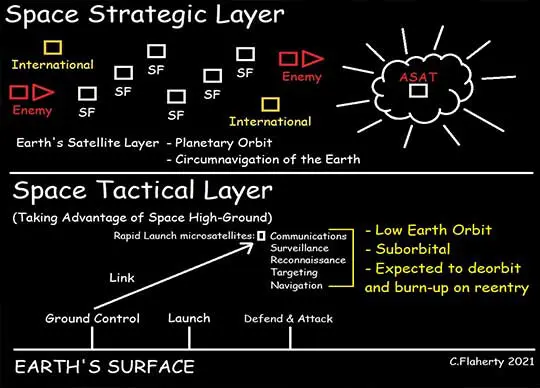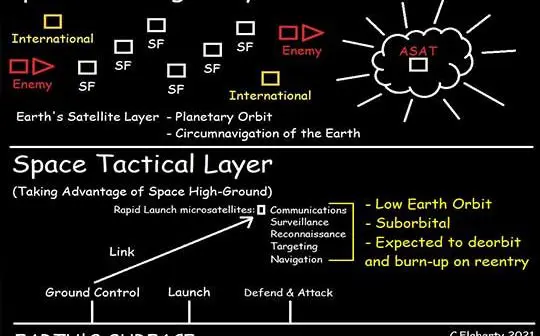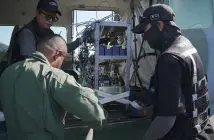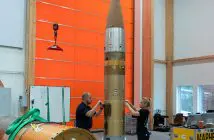
By Dr Chris Flaherty, My Space War Analysis Lab
INTRODUCTION
Some 60 years of Space Exploration, and Military-Use of Space Technology have matured to the current point, where recent major advancements have seen several countries create dedicated Space Forces. Over that same period of history a series of Space Warfare concepts and definitions have developed, and changed. The key among these ideas about the conduct of Space Warfare, are the properties given to understanding the implications of a layer of permanently-placed satellites in orbit around the Earth. Understanding about the layer of satellites continues to change, in regards to Space Warfare concept development. This article will look at two sets of definitions that will come to dominate Space Warfare concepts. The first set, is emergence of distinct Space Strategic and Tactical layers. The second set, is a distinction between Aerospace, and Space. The consequence is that the notion of Space ‘as the ultimate high ground’, which is the oldest of all the Space Warfare concepts, emerging as it did with the pre-1960s attempt to build a Space Bomber, and the Orbital Battle Station, changes into a new recast-form, demarcating the line between the Aerospace and Space, and the Space Strategic Layer, and the Space Tactical Layer.
AEROSPACE, SPACE, AND THE SPACE HIGH GROUND
Historically, the notion of the Aerospace was largely coined in the later-1950s as a way to explain the contiguous relationship between two mediums: the Air above, and Space above that. Evolving since the beginning of the 20th Century as a realm of combat, to be a place where craft like the German V2 Rocket by the end of WW2 had the ability to fly to the Edge of Space. Advances in rocket technology, and birth of the satellite, saw introduction of the notion of Earth Circumnavigation. A vehicle could escape Earth’s gravity, fly around the Earth dominating its surface. The original technological concept was for a craft to pass from the medium of the Earth’s Atmosphere, and into Space. Space Bomber Technology, aiming to surpass the Stratospheric Bomber, and create a reconnaissance craft achieving global surveillance, ultimately gave-way to the first reconnaissance satellites, and intercontinental missiles. The Aerospace emerged as a notional construct, that captured the three-dimensional battlespace, beginning at the Earth’s surface, continuing through the air above, and without interruption into Space. The Space Layer above the Earth’s Surface became the ultimate high ground, which still holds a central place in current Space Warfare thinking.
CHANGE DRIVERS
The reason why we are seeing a major recasting of many Space Warfare concepts, and emergence of new definitions has been largely technological. Change drivers impacting Space Warfare concept development has been size, cost, and access – availability, for both satellites and rocket launch options. There has been creation of a suite of various satellite sizes: ranging from microsatellites (CubeSat, and miniature satellites), medium (under 500 kilograms), and heavy (multi-ton) payload satellites, the numbers of these available, and increased ability to build these on a production-line.
The miniaturization of satellite technology, have allowed consequently for smaller payload launches, and small-scale rocket options. The traditional approach to satellite launch has been use of large scale custom-made, in reality hand-built, single-use rockets that launch from a limited number of sites, during specific launch windows, that in some cases can be delayed by several years. Limitations imposed by ride-along option launches – the satellite is carried along with a large-scale satellite (that is the main reason for the launch), have given way to a much more liberal set of ride-alone options, along with increased variety of launch options across the Earth’s Surface, including mobile options for small payload rockets horizontally, from an aircraft, and vertically from sea and submarine launchers.
The massive upswing in launch options, declining price, and raising access and availability – are causing a Space Warfare Revolution. The other major change has been a recent production-shift from a single craft construction to a line of reusable flight vehicles. The most recent change has been the 3D Printing of a complete rocket, the simplification of its parts and components, and production-line construction. A similar version to this production-line approach also exists with Carbon fibre rocket fabrication techniques, or steel sheet construction of the Starship.
THE EARTH’S SATELLITE LAYER
The rapid change in factors such as size, cost, and availability of satellites, rockets and launch options have begun to separate the Earth’s Satellite Layer. The Satellite Layer is a phenomenon that has been growing since the start of the Space Age. It is a mass of Low, Medium, and High Earth Orbits of working satellites, the Space Stations (International Space Station and Tiangong), and Space Junk that permanently circumnavigates our planet, much like Saturn’s rings. The Satellite Layer has become a central piece of strategic geography in Space, in much the same way that Astropolitics currently identifies favoured orbits, orbital flight paths, transfer orbits, gravity wells, and the Lagrange Points as the Strategic geography of Space. A demarcation can now be identified where there are effectively two different types of Satellite Layer: its Strategic Layer, and its Tactical Layer.
FIGURE 1: The Strategic Satellite Layer. This is composed of long-term Civil and Military-Use Satellites (many of which are dual-use), that are larger and mostly in settled orbits, or in Geostationary (Geosynchronous Equatorial) Orbit. Satellites in the Strategic Layer, which also includes the Space Stations, and likewise have long-term functionality in Space. The Strategic Layer satellites are larger with increased capacity for Space Manoeuvre. More recently these have been seen as the first Space Fleet of Spaceships, in current U.S. Space Force doctrine. It is expected, these craft, while remaining uncrewed (controlled from the Ground), will continue to evolve with increasing capacity to operate more like Spacecraft, with greater Space Manoeuvre, defensive capabilities, that will likely be a type of armament (currently expected to be lasers), and armoured from ASAT attacks.
Space Manoeuvre, at the Space Strategic Layer will resemble a ‘shell game’ within satellite clusters or constellations – where a satellite function is concealed, or moves between a group of satellites in order to preserve it against attack. It can also be rapid launch; or, Babushka Doll Satellites: a satellite designed to carry several within it, jettison these into new orbits, or attack vectors, aimed at other satellites; or satellites with a high-level of Delta-V (stored fuel to change orbits). As Ground Control is a significant aspect, Link Manoeuvre – shifting the line of communication between Ground Control and a satellite is another core concept. It also relates to having multiple fixed and mobile Ground options (Manoeuvre of the Ground component), which may or may not be located within national territory. The later, raises questions about international cooperation and mutual security between allies, and partner countries than may host key elements of global mission control and satellite tracking, and the fact that these could be targeted in a Space War.
FIGURE 1: The Tactical Satellite Layer. Technology to create a Space Tactical Layer, throws up a number of fundamental definitional issues, that have evolved from the first U.S. Space War: the 1991 Persian Gulf War. In that war, in support of Coalition operations a large number of Military-Use, and Civil Satellites were rededicated, and in some cases shifted from their original orbits, in order to support Navigation, Surveillance and Reconnaissance. This achieved a new form of dominance over the Iraqi Forces in Kuwait, and Iraq proper. Even though this early satellite use had direct tactical effect in the 1991 War, in many respects this reflected the creation of a largely Space Strategic Layer.
Even though Space Tactical Layer satellites perform much the same suite of functions, as the long-term strategic functioning satellites; it can be argued, these perform their functions in a much more immediate sense. The Tactical Layer satellites will have less Space Manoeuvre options, carrying less fuel capacity – usually only enough to manage a safe deorbit to burn-up on reentry. In actual fact, it can be expected that the Space Tactical Layer satellites will have relatively short-term life spans, lasting only in Suborbital flight-paths, or perhaps only a few orbits of the Earth, as these are expected to deorbit and burn-up on reentry.
THE SPACE TACTICAL LAYER
FIGURE 1: Currently, a plausible scenario exists where an opponent can use a variety of Space Denial technologies to block access to U.S. Global Positioning System Satellites. The Space Tactical Layer is used in the context of a package of U.S. Army Futures Command capability projects exploring the use of satellites in Low Earth Orbit giving soldiers dedicated Communications, Surveillance, and Imaging capabilities. Use of tactical-level Space-Based sensors with supporting ground-based equipment, is envisaged to improve on Positioning, Navigation and Timing, in substitution of battlefield scenarios where access to GPS is jammed.
The Space Tactical Layer also encompasses an expansion of capabilities for a terrestrial-based force, enhancing Reconnaissance, Deep Area Sensing, Rapid Targeting and Battlefield Situational Awareness, provided by rapidly positioned satellites. Current thinking, is that satellite services will come from microsatellites (CubeSat, and miniature satellites), rapidly launched by small-payload rockets, from mobile horizontal or vertical launch platforms, that can reach the Suborbital, and Low Earth Orbits of Space directly over a Theatre of Operations. In much the same way, a largely similar concept to the Space Tactical Layer is emerging in relation to environment and land management, farming, firefighting, policing and security, boarder security, even logistics, transportation and commercial operations. Even off-world the Mars and Lunar Reconnaissance Orbiters will perform the same functions in relation to future Human and Robotic missions.
SPACE SECURITY AND SPACE DEPENDENCY
FIGURE 1: The Space Strategic and Tactical Layers, looks at a set of relationships, that uniquely distinguish the conduct of war by the rival Superpowers, the U.S. and its Allies. There are varying levels of dependence on Space Infrastructure. This dependence also extends to wide number of users, many of which are countries that are fundamentally dependent on others who provide Space services, guarantee and secure those services, such as: Global Communications System, GPS, Commercial Exchange etc. This Strategic Satellite Infrastructure (which is largely in International Stewardship), has the same value as any National Critical Infrastructure; and has to be similarly protected and defended. Many countries are dependent on Space, but have no capacity to protect their access to it, so they are depended on the Space Guardians (to use a U.S. Space Force concept), maintained by one of the major Space Powers to ensure that access continues. Significantly, Space Forces, not only have national responsibilities, but also an equally important international duty to the dependent to protect and defend satellite access for all.
FUTURE SPACE WARFARE
FIGURE 1: Notionally a future Space War, may likely take three concurrent forms: (1) Battle in the Strategic Layer; (2) Battle at the Tactical Layer; and, (3) A ‘third variation’ where there is an exchange between the two layers, as these coincide during an orbital overfly, coinciding with a particular place on the Earth’s surface during its rotation. An object in Space, such as the International Space Station, travels around the Earth at some 27,580 kilometres per hour. During a 24 hour period, the Station orbits the Earth about every 90 minutes, completing an orbit approximately 16 times a day. Comparatively, a satellite can be locked into a Geostationary (Geosynchronous Equatorial) Orbit: a high Earth orbit allowing it to match Earth’s rotation. The orbit position is a valuable location for monitoring weather, communications and surveillance, and generally gives a large area of Earth surface coverage. However, it is vulnerable to attack. Most satellites are orbiting, only coming overhead of a geographical area at regular intervals.
Effectively, there can be two Space high grounds, one in situ (at the Space Tactical Layer), and another overhead (at the Strategic Layer), coming into play at a macro-level of conflict for a period, before it passes out of range. The Space Tactical Layer, operating at the Edge of Space boundary, operates as a secondary system of overlay, providing: Communications, Surveillance, Reconnaissance, Targeting, and Navigation; also Timing, Imaging, Positioning, Deep Area Sensing, Rapid Targeting and Battlefield Situational Awareness. It can be envisaged that an exchange between the two layers can occur; a Space Strategic Layer weapon can be used against Ground, or Air Targets. For instance, the use of a Space-Based laser weapon to destroy a Ground Target. However, from a roles-functions perspective its use is dependent on what other more economical options are there to be used. The other consideration is in the Space Domain are there more high-priority Targets. One of the main qualitative differences between the Strategic and the Tactical Layers is that the Space Force of Fleet Spaceships will operate within a complex set of orbital relationships, among ‘International Satellites’ and the Enemy ones. The major limitation is the threat posed by the use of ASAT Kinetic Weapons, or any weapon that could potentially explode a satellite. The resulting Space Debris Phenomena rapidly weaponizes, causing massive potential risk to orbital paths, destroying and damaging other satellites, and the Space Stations, that could significantly shut-down not only the combatants, but the dependent’s access to Critical Space Infrastructure.
AUTHOR: Chris Flaherty is a Space & Defense Tech and Security News Regular Contributor.





